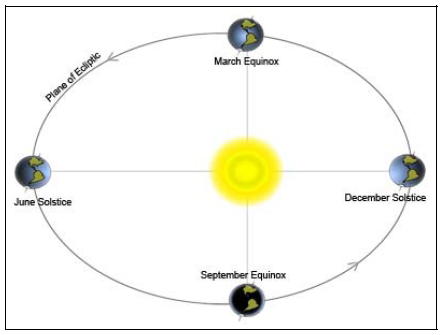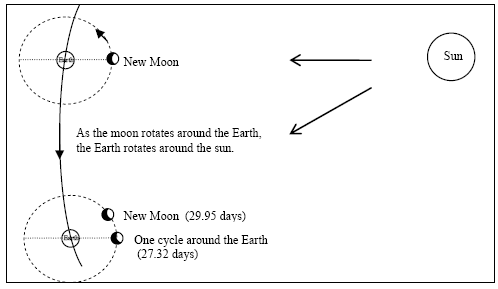
Figure 1: Solstices and Equinoxes (Not drawn to scale)
The calendar is a system of reckoning time. It is based on astronomical events such as the movement of the moon relative to Earth and the movement of Earth relative to the sun to determine time cycles such as day, month or year. The internationally accepted calendar used today is based on the sun, called the solar calendar. The lunar calendar reckons time based on movements of the moon. Additionally, there is also a type of calendar based on both the moon and the sun, called a lunisolar calendar.
Cambodians use two types of calendars: the international calendar for civil purposes and the traditional calendar for religious purposes. Although called Chhankitek, which means lunar calendar, Khmer traditional calendar is a lunisolar calendar similar to some of the Hindu calendars and the Chinese calendar.
To introduce basic concepts of the calendar systems, we will start with the basics of measuring time using astronomical events. This includes the movement of the Earth and the moon.
As the Earth rotates on its axis, it also revolves counter clockwise around the sun in an elliptical orbit forming an ecliptic plane. On this plane, there are four markers called seasonal markers that astronomers have identified (See Figure 1).

An astronomer named Hipparchus discovered that as the Earth rotates around its axis, the axis also revolves in a circle at a rate of about 25,800 years per revolution. The revolving axis forms a cone section of approximately 23.5 degrees. This phenomenon, called the Precession of Equinoxes, causes the equinoxes to drift slowly clockwise since the position of the equinoxes depends on the angle of Earth's axis with respect to the ecliptic plane.
One year is the length of time that the Earth revolves once around the sun. A year can be measured in two different ways.
One sidereal year is exactly one revolution of the Earth around the sun. This is typically what we might think of as a year, but this measurement is not commonly used. The most commonly used measurement is the tropical year, used in the Gregorian calendar.
Although seemingly similar, the sidereal and tropical year differ in one important aspect. In the tropical year, the distance from a March Equinox to the next March Equinox is not one complete revolution. This is due to the precession of the equinox. The equinoxes drift slowly in a clockwise direction about 50 degrees per year. Thus when the Earth starts at a March equinox, it does not return to the same position at the end of the year. It is short by approximately 20 minutes or 50 degrees.
To illustrate how these two measurements are different, we first look at the moon phases as projected by the sun. The sun lights up one side of the moon and observers from Earth see different phases of the moon depending on the location of the moon relative to Earth and the sun. When the moon is between the Earth and the sun, we only see the dark side of the moon, called a new moon.
As the moon continues to revolve around the sun, we start to see more of the bright side of the moon. This moon phase is called waxing. As the moon revolves a quarter-way around Earth, we see the moon when half of it is dark and the other half is bright. At this point, it is called the first quarter.
When Earth is positioned between the moon and the sun, we see only the bright side of the moon, called a full moon. As the moon continues to orbit Earth, we start to see the dark side of the moon again. This phase is called waning. We continue to see more of the dark side of the moon until it is completely dark.

As the moon revolves around Earth, Earth also revolves around the sun. If we start at the new moon when the moon is between Earth and the sun in a straight line, as the moon completes one revolution around Earth, Earth has already moved some distance around the sun. Consequently, after one revolution, the moon's position relative to Earth and the sun is no longer in a straight line. It takes almost two more days in addition to 27.3 days for the moon to be in a straight line again. At that point, the cycle begins anew. The whole cycle takes about 29.5 days, which is the measurement for a Synodic month.

Solar calendars use the tropical year to measure time. The international calendar in use today is the Gregorian calendar, also referred to as a western calendar. This calendar was derived from the Julian calendar and then further improved for better time approximation. Furthermore, Julian and Gregorian calendars determine leap years differently.
In the Julian calendar, a leap year occurs every four years, which means there are 365.25 days a year. A normal Julian year is 365 days and a leap year is 366 days. Julian leap years are divisible by 4.
On the other hand, Gregorian calendars approximate a year to be 365.2424 days which is closer to the tropical year. To accomplish this approximation, Gregorian calendars use the following rules in determining leap years. A leap year occurs every four years with a special exception for century years. A century year is not a leap year unless it is divisible by 400. For example, 1900 is not a leap year while 2000 is a leap year.
Lunar calendars use the moon phases to determine the length of a month. Each month usually starts from one new moon to the next. Since each month is approximately 29.5 days long, one lunar year (12 months) is only 354 days, which is 11 days shorter than a tropical year. The shortage of days will cause the seasons to drift steadily. Seasons in lunar calendars regress over a 33 year period. An example of a purely lunar calendar is the Islamic Calendar.
In order to coincide with the seasons, the lunisolar calendar adjusts itself to the tropical year. One normal lunisolar year has 12 months but an extra month is added every 2 to 3 years to compensate for the shortage of days. Examples of the lunisolar calendar include the Chinese calendar, some Indian calendars, and Khmer calendar.
| << Introduction | < Table of Content > | Khmer Chhankitek >> |